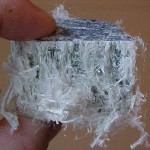 I have written here about various ways in which nanomaterials may be comparable to asbestos – both in the ways nanoparticles may impact the human body and the ways the law may respond. So it’s not surprising that one more comparison has emerged recently.
I have written here about various ways in which nanomaterials may be comparable to asbestos – both in the ways nanoparticles may impact the human body and the ways the law may respond. So it’s not surprising that one more comparison has emerged recently.
Scientists from Brown University have studied the impact of carbon nanotubes on mouse cells. Their study, published in the September 19, 2011 issue of Nature Nanotechnology, showed that certain types of multi-walled carbon nanotubes enter cells in a way that causes an immune response and cellular inflammation. The physical properties of the nanotubes are responsible for this reaction. As the researchers stated in their abstract, “cylindrical one-dimensional nanomaterials such as carbon nanotubes enter cells through the tip first.” Certain nanotubes – those with end caps or carbon shells at their tips – seem to trigger the inflammatory reaction. The researchers mention asbestos fibers in their abstract as being analogous (though they are clearly physically different) in this important aspect.
Does this mean that carbon nanotubes will create the same health problems that asbestos created? Not necessarily. Some might consider asbestos-related illness to be one of the major scourges of the last quarter of the 20th Century and well beyond. Asbestos has shaped the law in relation to workplace safety and mass tort litigation, and has transformed industry. Asbestos is a naturally occurring substance, and its use has been limited since the 1970s. Its health effects, however, are ongoing because symptoms of asbestos-related disease typically occur after a latency period that may be quite long.
Nanomaterials, however, are engineered and represent new technology in a new technological world. A new response is warranted. What can be done going forward? Scientists may be able to engineer carbon nanotubes in a way that will eliminate this particular inflammatory response. But more research needs to be done before that. For example, these same researchers intend to study whether nanotubes with others types of tips create the same or similar cellular response.
For now, we may be heading in the direction of “intelligent tip modification,” as the researchers refer to it. Let’s hope we aren’t headed down the asbestos road again.
The abstract of the article may be accessed at
http://www.nature.com/nnano/journal/vaop/ncurrent/full/nnano.2011.151.html
For a report on the Brown University study, see the following piece in the BNA subscription service:
Greg Hellman, Researchers Show How Carbon Nanotubes Pierce Cells, Leading to Inflammation, 18 Daily Env’t Rep. (BNA) A-12 (Sept. 20, 2011).

This is good to know. I’ve been doing more research over time. I have spoken with a few clients that mentioned a prior work history and exposure to nanomaterials. Of course any microscopic particle that can build up in your system overtime will naturally cause health issues. As I move further along in this it looks like I’ll have to continue my research. Thank you so much for sharing this blog.
It would then create a big health concern if people were unaware of the dangers of using carbon nanotubes. If these are indeed true, citizens who gets affected through cellular inflammation could definitely file a case against the manufacturers of the aforementioned product.